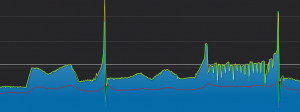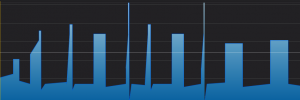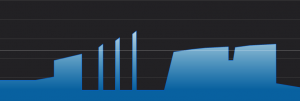8DC Wrap-Up
 With the final stage of TrainerRoad’s “8 Days of California” behind us, let’s take a day or two to bask in the well-earned sense of accomplishment that ought to beset all who made it through the tour in its entirety as well as those who took part in whatever capacity life allowed and let’s also allot a few minutes to inventory what was accomplished over the course of eight consecutive days of workouts. Because while it may have seemed like this was just a fun excursion, there was actually a method to our madness when it came to the design of this series of workouts.
With the final stage of TrainerRoad’s “8 Days of California” behind us, let’s take a day or two to bask in the well-earned sense of accomplishment that ought to beset all who made it through the tour in its entirety as well as those who took part in whatever capacity life allowed and let’s also allot a few minutes to inventory what was accomplished over the course of eight consecutive days of workouts. Because while it may have seemed like this was just a fun excursion, there was actually a method to our madness when it came to the design of this series of workouts.
First and foremost, overload was the umbrella objective both in a general sense but also in a number of specific senses. Clearly, that much work within such a compact period of training takes a heavy toll on the body as a whole and given adequate recovery will allow your capabilities to ascend to new heights, but the types of efforts doled out over the course of the tour each had their own objectives in terms of growing specific capabilities. Sprinting repeatedly (lactate production), riding at your peak aerobic output time & again with minimal recovery (aerobic power), pushing you to the height of your sprint output (anaerobic capacity), asking you to ride for extended, continuous periods of time forcing you to rely on straightforward endurance (aerobic base), and even some speed & form work thrown in for good measure all culminate in a well-rounded training scenario that illustrates how necessarily complete a cyclist’s fitness must be in order to contest or even complete a stage race.
And while stage racing might not even be on your radar, the benefits bestowed upon athletes who undertake such challenges, either in competition or simply as training, can change a rider forever. If you’ve ever closely followed the Tour de France, the Giro d’Italia or the Vuelta a Espana then you’ve heard coaches, athletes, team directors, commentators remark on how a grand tour ‘changes’ riders. What you may not have fully grasped before 8DC was the depth at which these changes take root. While this event wasn’t a grand tour, over its course both physiological & psychological cascades of events were set into action. Riders inevitably learned that their bodies were capable of more than they’d imagined and just this glimpse of control over something intimidating and rigorous & the accomplishment that follows its completion can bring a new level of confidence and ambition that no typical training plan can foster via the usual, work/rest/work/work/rest paradigm.
This isn’t to imply that everyone improved over the course of the tour or that every day felt like an effective workout, because far & away the majority of the benefits conferred by such an undertaking are days, even weeks, away from reaching their potential. This is part of the reason we scheduled this training block at a time of season that allows many competitive and even recreational riders an opportunity to heap on a ton of training stress, recover for few days via time off the bike (today, for instance, tomorrow too?) and a couple days of easy riding (Tuesday, Wednesday…Thursday? Friday??) while paying close attention to their rate & level of recovery in time for their fitness rebound to correlate with summer’s first key events in June and even into July.
So while you may feel beat down & broken right now, taking it easy on yourself for a few days and then easing back into your training plan over the course of this week will undoubtedly bring you to a new level of performance down the road. And if you had the good sense & flexibility to schedule 8DC prior to a recovery week then you’re already on the right track. In either case, this means that you have to take your recovery seriously if you don’t already. Proper nutrition over the course of the tour (see Amber’s post on Stage Race Nutrition), proper sleep during the tour both in the form of naps (should your lifestyle afford them) and adequate rack time each night & ample recovery following 8 straight days of workouts (especially for those riders who have never undertaken such a heavy block of training) are imperative and skimping on any one or more of these facets of recovery will only hamper future performance and even negate some of the positive effects you would typically derive from a heavy dose of training overload.
Finally, it’s worth pointing out that the barrage of efforts & workout formats inflicted on you over 8DC were also intended to pinpoint weaknesses & even limiters (weaknesses that limit your intended performance) by exposing you to aspects of riding you might usually try to avoid. How’d the sprints go? How about surging toward a KOM after a 30-second power ramp? How about doing that a second, third time, fourth time!? Did you measure an improvement in your FTP over the course of stage 6 even with heavy fatigue in your legs? Maybe you saw impressive 2-minute output during stage 4 but fell apart when you tried to extend that output to 3 minutes? In any case, you must have learned something about yourself as a cyclist in general and perhaps about yourself as a stage racer in particular and even took the time to make a few notes in a training log such that you actually grow from the experience and can compare notes when 8DC rolls around again next year!
I know, I know, that’s probably the last thing you want to think about right now, especially if you really buried yourself during the inaugural edition of 8DC. But performance gains beget performance ambitions so prepare yourself for a new outlook that’s bound to accompany the gift you’ve given yourself by pushing your limits, day after day, with hundreds of other like-minded athletes, all in the interest of fun & greater fitness. So rest up, then get out there and tear some legs off; you earned the satisfaction.




